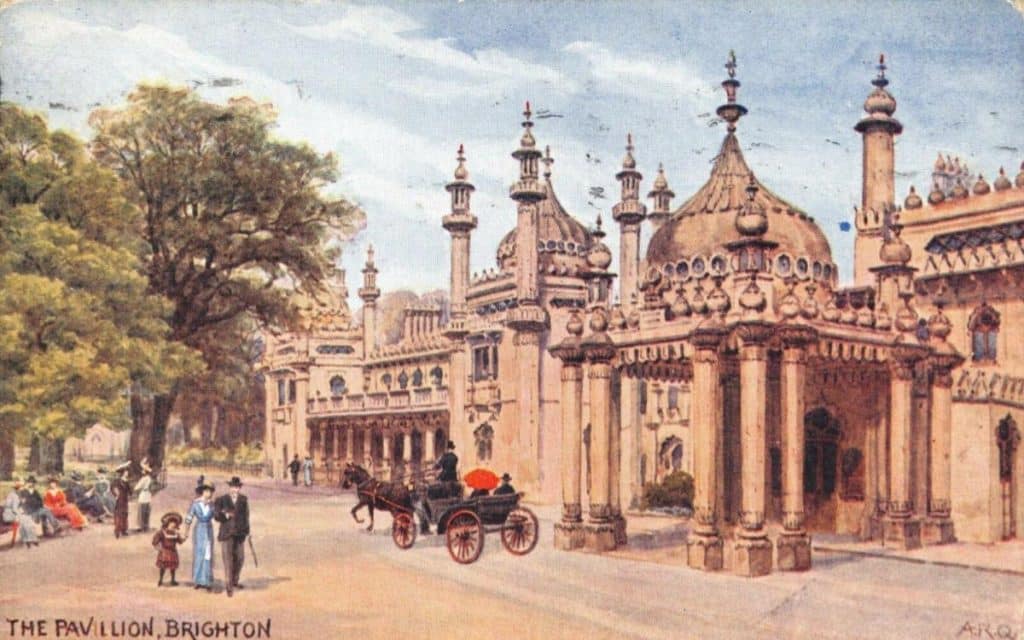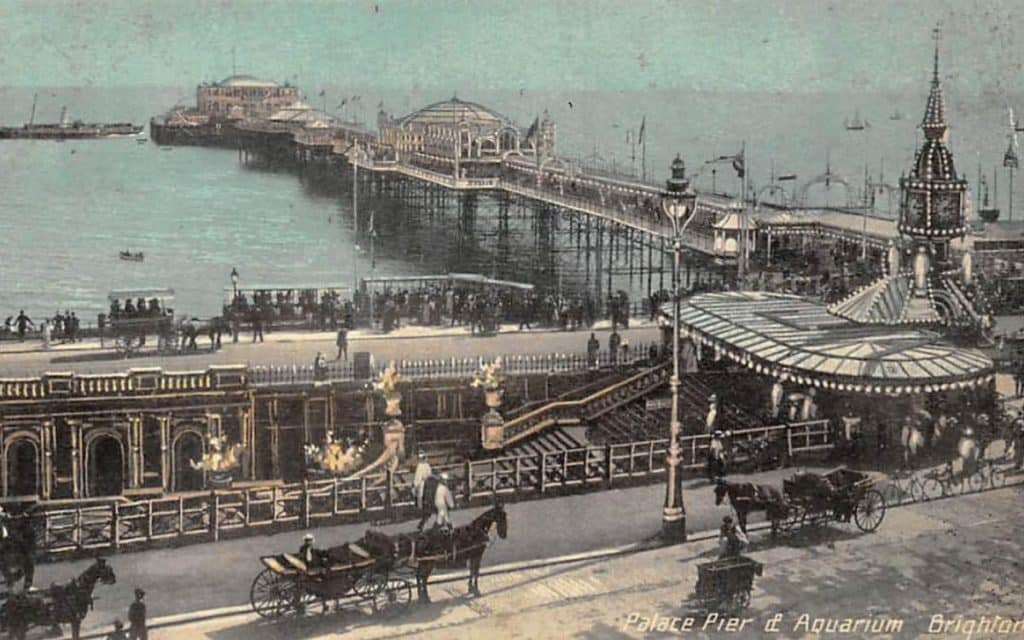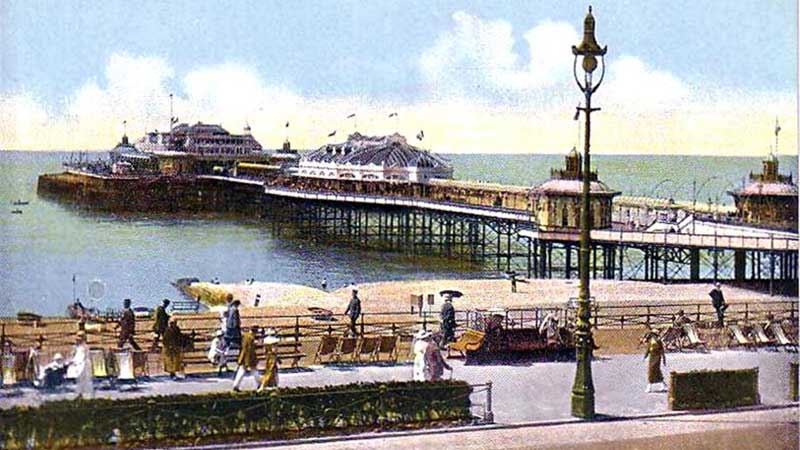Brighton and Hove are holiday meccas by the sea – but according to guest writer A.L. CUIN, of British Paranormal, they can be plenty spooky too!

Brighton prides itself on being one of the UK’s most exciting and forward-looking cities.
Dubbed “London-by-the-sea”, each year Brighton welcomes hundreds of thousands of day trippers and holiday-makers, who flock to the coastal location to enjoy the gaudy entertainment and garish culture.
However, beneath the merry, candyfloss-coated facade lies a dark and troubled history.
Since the dawn of human civilisation, Brighton has witnessed countless tragedies and disasters, as well as innumerable murders, executions, wars, plagues and famines.
Although many of these incidents have been lost in the sands of time, the traumas of the past have nonetheless left a deep, psychological scar on the city, a fact that is made manifest by the large number of ghosts that haunt modern Brighton.
From drowned children to decapitated soldiers, the city plays host to a shocking array of lingering spirits.
Here’s just a few of Brighton and Hove’s most terrifying ghosts:
The Marlborough Pub and Little Theatre
The Marlborough is a little-known Brighton gem, situated directly opposite the Royal Pavilion.
Dating from the late 18th Century, the Marlborough is the embodiment of Brightonian quirkiness. The narrow Georgian bar sits below a tiny theatre, capable of accommodating only a handful of guests at any one time.
The venue has played host to countless intimate events, entertaining scores of visitors over the generations.
However, according to local legend, many guests have left the theatre with more than just memories of a good night’s fun. They have also experienced a once-in-a-lifetime paranormal event.
Like its host city, the Marlborough Pub and Theatre has a secret past that is shrouded in darkness and terror.
In the mid-Victorian period, the landlord of the venerable establishment was convicted of murdering his wife on-site by pushing her down a long flight of stairs.
According to rumour, the assault was not sufficient to ensure the victim’s prompt dispatch. She was injured mortally, but did not die immediately.
In an effort to ensure a complete job, the landlord carried his dying wife down to the pub’s cellar, where he she spent her final hours, helpless and in agony.
Since the notorious murder, inexplicable phenomena have been repeatable reported at the Marlborough, leading many to speculate that the venue now plays host to an unhappy spirit. Orbs are regularly reported in the cellar area and on the stairs leading to the theatre.
Pained, disembodied shrieks have been reported by entire audiences and on one occasion a ghoulish apparition is said to have appeared in front of 12 guests, hovering on the stage mid performance.
Over the years the Marlborough has endured a total of six recorded exorcisms, but to no avail.
In 2007 a female visitor reported seeing a pallid, pale woman with a mournful disposition float across the theatre, several inches above the ground.
Hanningtons
Mention Hanningtons to anyone who is new to Brighton and they will likely return a blank expression.
This is despite the fact that the once famous department store was formerly the toast of Brightonian retail life. Today the huge building that once housed the City’s very own version of Graceson Brothers has been carved-up between numerous faceless, corporate concessions and boutiques.
Despite the modification to the premises, memories of the past have proved difficult to expel entirely.
The residue of years of history and emotion remain discernible and tangible, especially due to the efforts of the restless spirit of one of Hannington’s most devoted former employees.
Maria Gibson worked at Hanningtons all her life. Her tenure at the department store started in 1897 when she was just a girl and lasted to 1960s. During this time she worked her way up from shop girl to department manager. Maria was infamous for running a tight ship. She would not tolerate tardiness, poor customer service or immodest behaviour. Imagine therefore, the distress that must have been caused to Maria’s spirit when the 21st Century hit Hanningtons.
Witnesses to Maria’s ghostly activity have included some of Brighton’s most prominent citizens. According to reports, Maria is particularly angered by some of the items that are now sold in the various boutiques that inhabit the corpse of Hanningtons. Handbags, mini-skirts and lingerie are regularly reported to go missing. Alternatively, items are thrown in the face of customers, in a demonstration that modernity is not welcome at Hannigntons.
The West Pier
Most ghost stories are in some way romantic. Whether you are dealing with the tale of a murdered wife or the story of a deceased soldier, there is normally an element of positive (if twisted) emotion attached to the story somewhere. That said, there are many exceptions that break this rule and the ghost of the West Pier is one such exception.
The West Pier’s most active ghost inhabits quite a wide geographic area, encompassing most of Brighton’s seafront, as well as the the area known as Hove Lawns. Sightings have even been reported in the various clubs that now inhabit Brighton’s seafront arches.
The West Pier ghost is said to date from the late 1980s and is thought to have been a homeless victim of a drugs overdose. Witnesses describe a gaunt, pale looking girl, dressed in tattered clothing, who appears huddled in doorways and architectural crevices.
When she is brought into full view, the troubling apparition vanishes from sight, leaving terrified witnesses traumatised for life.

One particularly unpleasant encounter with the West Pier ghost dates from the late 1990s. A group of party-goers had forsaken the seafront clubs in favour of a beachside bonfire.
Having spent a few hours huddled around the warming embers, a small party of merry-makers decided to look for a secluded spot where they could answer the call of nature. They decided to take it in turns to dart behind the then derelict Brighton bandstand. All went well until the final person came to relieve himself.
According to reports, his companions suddenly heard a blood curdling scream, then saw their compatriot fleeing the bandstand in terror. When questioned as to what had caused his fear, he explained that the spirit of a young girl had suddenly manifested in his peripheral vision.
Saint Anne’s Wells
These days the word “neon” pretty much defines the culture of Brighton, but once upon a time, the story was very different. Brighton’s history stretches back to the dawn of humankind. The very first inhabitants of the area were pagan cannibals, who devoured the bodies of their defeated enemies in ritualistic celebrations.
Later on, a priestly caste of Celts was said to rule Brighton’s green and pleasant land, conducting otherworldly ceremonies throughout the city’s confines. The Celts were followed by the Romans, the Angles and the Saxons, each of which worshipped at Brighton and Hove’s various holy sites and shrines.
One location that remained venerated and holy throughout Brighton’s changing culture was the spring at Saint Anne’s Wells. The name “Saint Anne’s Wells” is likely to be an early-modern alteration. It is thought that the spring was probably first named “Annifreid’s Wells”, in memory of a Saxon princess.
According to local legend, Annifreid’s husband was murdered and when news of his death reached her, she burst into tears. When the tears hit the ground, a well sprang up, which became known as Annifreid’s Well.
Whatever the origins of Saint Anne’s Wells, the location is known to be a hotspot for paranormal activity. Some commentators have even speculated that the popular Brighton park that now hosts the spring could be a crossover point between the material world and the spirit world, popularly known as a “hellmouth”.
Reports of demonic children are particularly popular, with one account from 1896 talking of a hoard of “demented youths with cat-like eyes” terrorising a party of Brighton merchants and businessmen.
In 1993 a Japanese student was admitted to Brighton’s Royal Sussex County Hospital, suffering the symptoms of severe shock. When questioned as to what had caused her trauma, she claimed to have been approached by the devil whilst passing through the Saint Anne’s Wells area.
Brighton Library Area
It’s hard to believe these days, but Brighton really took a pounding during the Second World War. The City was used as a dumping ground by Luftwaffe pilots, who were keen to jettison unused bombs before beating their retreat back to the Continent.
Notoriously, in 1940 the Odeon Theatre in Kemptown was bombed during a matinee performance, attended by many local school children. The death toll was shocking. This was coupled with machine gun raids on terrified pedestrians, caught off-guard by the daylight, airborne assault. Brighton was declared to be part of the “front line” of military combative action. The beaches were closed, the piers were partly dismantled and routes in and out of the city were constantly under guard.
One area that suffered particularly badly as a result of the “Brighton Blitz” was the roads and streets between North Laine and the Royal Pavilion.
Today this part of the city is host to Brighton’s magnificent modern library, as well as the Prince Regent’s Swimming Pool and a number of slick looking shops and offices. Physical traces of the bloody slaughter that took place there have all but disappeared. However, this has been quite a recent development.
Right up until the early 1990s, the area still contained the remnants of bombed-out buildings. The location also hosted several ghosts, who many believe were victims of the vicious air raids. One particularly prevalent apparition was said to be the spirit of a small child, dressed in pyjamas and clutching a tiny, wooden toy.
He was often described as being in a state of distress, crying or howling, as he darted through the ruins.
When concerned witnesses attempted to locate the child in order to ascertain what was wrong, they invariably discovered that he was nowhere to be seen. Sightings are nearly always preceded by the inexplicable noise of a droning aircraft.
Have you seen a ghost in Brighton and Hove? Tell us about it in the comments section below!




Good ghost stories. I hadn’t heard of them before.
Pretty awesome stuff, I never knew until recently that there was so much paranormal activity going on in the city!
So I have found my old house. Mansell cottage , London Road, Patcham (next to robin hood petrol station). It was a semi detached house on the left hand side as you went past the petrol station on the left heading out of Brighton. It is now the Bridge support of the flyover next to the new petrol station just off the roundabout. A well haunted place.